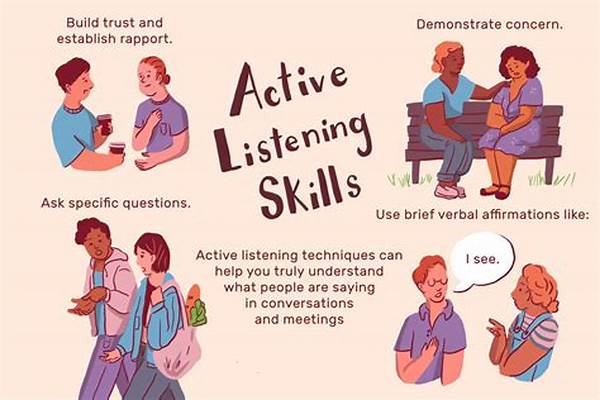Embracing the Power of Silence
In the hushed corner of a bustling café, two artists sat, surrounded by the quiet hum of conversation and clinking coffee cups. Amelia, a budding painter, nervously presented her canvas to her mentor, David—an illustrious figure in the world of art. As she unfolded her thoughts about the brushstrokes and colors, David sat silently, a gentle nod here and a soft smile there. It wasn’t just his silence that spoke volumes; it was the attentiveness he exuded. This moment was a reflection of the role of active listening in critiques, which often holds the power to transform apprehensions into confidence.
Read Now : Identifying Strengths In Acting Auditions
The room may have been filled with noise, but Amelia felt heard in its truest sense. David, through his genuine silence and intent focus, created a safe space for Amelia to express her creativity. She realized that trust was engrained in the fibers of her artwork, woven by the threads of active listening. The canvas began not with a splash of paint but with the unspoken dialogue that flourished in David’s attentive gaze. In critiques, it was not just words that mattered but the silence that nurtured the understanding behind them.
For Amelia, this session wasn’t about faults highlighted or applause given; it was about connection—a bond built on the foundation of the role of active listening in critiques. That café became the birthplace of newfound insights, revealing how true artistry lies in understanding, both spoken and unspoken. As Amelia departed, she carried more than an assessment of her art; she bore the warmth of being genuinely heard, inspiring her to paint with more fearless strokes.
Hearing with the Heart
1. In a sunlit studio, James listened intently to Lucy, a young writer. Understanding the role of active listening in critiques, he mirrored the themes that resonated within her story, offering insights that sprouted creativity anew.
2. Margaret, a designer, once sat with her mentor, absorbing his unspoken wisdom. The role of active listening in critiques enabled her to see beyond colors, embracing the essence of storytelling through fabric.
3. During an informal gathering, Oliver heard Chloe’s ideas quietly. The role of active listening in critiques taught him that understanding wasn’t about immediate responses—it was appreciating silence that amplified Chloe’s voice.
4. An architect by trade, Thomas once faced criticism with dread. However, encountering a mentor who embraced the role of active listening in critiques transformed his fear into constructive dialogue, revolutionizing his designs.
5. In a music academy, Emma discovered that the role of active listening in critiques could turn discord into harmony. Her instructor’s attentiveness allowed her to express melodies more fluently and authentically.
The Unseen Dialogue
On a dimly lit stage, Sarah stood with trembling hands, facing her drama teacher, Miss Elliot. The silence was not discomforting but rather a canvas upon which dialogue painted itself. Miss Elliot knew the role of active listening in critiques was not just about hearing words but capturing the sentiment that lurked behind them. This understanding forged a connection between teacher and student, nurturing Sarah’s passion for theatre.
The enchantment of active listening wasn’t lost on Sarah. Miss Elliot’s gentle inquiries and reflective gestures encouraged her to explore emotions she hadn’t dared to tread before. It was not Miss Elliot’s critique that fueled Sarah’s growth but rather the space she provided for silence to voice itself, illustrating the invaluable role of active listening in critiques. Together, they ventured into the unknown, where insights unraveled with each attentive pause.
Whispering Insights
1. Active listening can foster trust between mentor and mentee in critique sessions, as demonstrated by Amelia and David’s interaction.
2. It encourages young artists to explore new perspectives, just as Sarah discovered through Miss Elliot’s guidance.
3. The absence of immediate judgment allows for deeper self-reflection, evidenced by James and Lucy’s shared understanding.
Read Now : Crafting A Standout Audition Portfolio.
4. Silence, embraced in active listening, often unveils unspoken truths, much like Oliver learned from Chloe.
5. This type of attentive engagement can transform fearful criticism into insightful dialogue, as seen with Thomas.
6. By engaging fully, mentors embody empathy, providing a foundation for creative exploration, similar to Margaret’s experience.
7. Feedback becomes more meaningful when mentees feel genuinely heard, which Emma identified in her music lessons.
8. Active listening reinforces the idea that critique is about collaboration, not correction, deepening mutual respect.
9. The process enhances creative expression by nurturing confidence, seen in Margaret and Sarah’s journeys.
10. Critiques grounded in active listening become a partnership in growth and innovation, a shared voyage toward artistic excellence.
Crafting the Narrative
In a world saturated with noise, the role of active listening in critiques becomes more profound, transcending its mere function as a feedback mechanism. It morphs into a narrative of empathy, understanding, and co-creation. Within critique spaces, silence interwoven with intent listening crafts stories untold, embracing every subtlety of the artist’s expression. This is where transformation begins—not just of the canvas, page, or stage, but of the artists themselves.
As mentors and protégés journey together into the realm of creative exploration, active listening becomes the silent protagonist of the story. In critiquing, it’s not just about pointing out what resonates or what doesn’t; it’s about journeying—walking alongside through the labyrinth of creativity and discovery. Every artist carries the echoes of a critique filled with active listening, which becomes a melodious harmony that encourages bold creativity and impassioned artistry.
Here, the role of active listening in critiques is unwavering. It silently wields a brush that paints invisible strokes across the canvas of human connection. In this space, critiques evolve into tales of personal growth—an anthology penned by mentors who listen with intent and artists who speak with courage. This narrative, rooted in active listening, whispers the promise of infinite creative possibilities, remaining a cherished guide for every artist.
